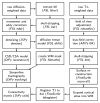Global and Local Connectivity Differences Converge With Gene Expression in a Neurodevelopmental Disorder of Known Genetic Origin
- PMID: 28168288
- PMCID: PMC6600876
- DOI: 10.1093/cercor/bhx027
Global and Local Connectivity Differences Converge With Gene Expression in a Neurodevelopmental Disorder of Known Genetic Origin
Abstract
Knowledge of genetic cause in neurodevelopmental disorders can highlight molecular and cellular processes critical for typical development. Furthermore, the relative homogeneity of neurodevelopmental disorders of known genetic origin allows the researcher to establish the subsequent neurobiological processes that mediate cognitive and behavioral outcomes. The current study investigated white matter structural connectivity in a group of individuals with intellectual disability due to mutations in ZDHHC9. In addition to shared cause of cognitive impairment, these individuals have a shared cognitive profile, involving oromotor control difficulties and expressive language impairment. Analysis of structural network properties using graph theory measures showed global reductions in mean clustering coefficient and efficiency in the ZDHHC9 group, with maximal differences in frontal and parietal areas. Regional variation in clustering coefficient across cortical regions in ZDHHC9 mutation cases was significantly associated with known pattern of expression of ZDHHC9 in the normal adult human brain. The results demonstrate that a mutation in a single gene impacts upon white matter organization across the whole-brain, but also shows regionally specific effects, according to variation in gene expression. Furthermore, these regionally specific patterns may link to specific developmental mechanisms, and correspond to specific cognitive deficits.
Keywords: atypical brain development; cognitive development; human genetics; structural connectome.
© The Author 2017. Published by Oxford University Press.
Conflict of interest statement
Figures






References
-
- Alexander AL, Hurley SA, Samsonov AA, Adluru N, Hosseinbor AP, Mossahebi P, Tromp do PM, Zakszewski E, Field AS. Characterization of cerebral white matter properties using quantitative magnetic resonance imaging stains. Brain Connect. 2011;1(6):423–446. doi: 10.1089/brain.2011.0071. - DOI - PMC - PubMed
-
- Avants BB, Tustison N, Song G. Advanced Normalization Tools (ANTS) Insight J. 2009 Retrieved from http://www.insight-journal.org/browse/publication/681.
Publication types
MeSH terms
Substances
Grants and funding
LinkOut - more resources
Full Text Sources
Other Literature Sources

